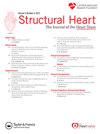Cardiac Implantable Electronic Devices and Transcatheter Tricuspid Valve Replacement With the EVOQUE System: A Case-Review Series Highlighting Procedural and Management Considerations
IF 2.8
Q3 CARDIAC & CARDIOVASCULAR SYSTEMS
引用次数: 0
Abstract
Severe, untreated tricuspid regurgitation is associated with worse clinical outcomes. While isolated tricuspid valve (TV) surgery has been linked to poor long-term outcomes, transcatheter TV therapies, including edge-to-edge repair and transcatheter tricuspid valve replacement (TTVR), have emerged as effective alternatives and have been shown to improve outcomes, leading to their regulatory approval in the United States. Conduction system abnormalities are commonly seen among patients undergoing TTVR due to the close proximity of the atrioventricular node and the His bundle to the TV annulus. In the TRISCEND II (Transcatheter Tricuspid Valve Replacement: Pivotal Clinical Investigation of Safety and Clinical Efficacy Using a Novel Device) trial, 38% of the patients had prior cardiac implantable electronic devices (CIEDs), while 25% of patients developed new conduction abnormalities necessitating implantation of new CIEDs. Concerns exist regarding trapping existing CIED leads during TTVR. Similarly, transvenous permanent pacemaker implantation post-TTVR has been reported to be associated with valve dysfunction. In this case-based narrative review, we describe case examples of patients with prior CIEDs undergoing TTVR and conduction abnormalities post-TTVR needing a new permanent pacemaker and discuss potential periprocedural strategies for optimal outcomes. Electrophysiologists specializing in periprocedural management of CIEDs, including lead extraction and post-TTVR device management, play a crucial role and should be part of a comprehensive heart team approach for optimal outcomes.
心脏植入式电子装置和经导管三尖瓣置换术与EVOQUE系统:一个案例回顾系列强调程序和管理方面的考虑
严重的、未经治疗的三尖瓣反流与较差的临床结果相关。虽然孤立三尖瓣(TV)手术与不良的长期预后有关,但经导管TV治疗,包括边缘到边缘修复和经导管三尖瓣置换术(TTVR),已成为有效的替代方案,并已被证明可以改善预后,从而在美国获得监管部门的批准。传导系统异常常见于接受TTVR的患者,因为房室结和His束离电视环很近。在TRISCEND II(经导管三尖瓣置换术:使用新型装置安全性和临床疗效的关键临床研究)试验中,38%的患者先前有心脏植入式电子装置(cied),而25%的患者出现新的传导异常,需要植入新的cied。在TTVR期间,存在捕获现有CIED引线的问题。同样,经静脉永久起搏器植入后ttvr已被报道与瓣膜功能障碍有关。在这篇基于病例的叙述性综述中,我们描述了之前患有cied的患者进行TTVR和TTVR后的传导异常需要新的永久性起搏器的病例示例,并讨论了可能的围手术期策略以获得最佳结果。专门从事cied围手术期管理的电生理学家,包括铅拔出和ttvr后设备管理,发挥着至关重要的作用,应该成为全面的心脏团队方法的一部分,以获得最佳结果。
本文章由计算机程序翻译,如有差异,请以英文原文为准。
求助全文
约1分钟内获得全文
求助全文
来源期刊

Structural Heart
Medicine-Cardiology and Cardiovascular Medicine
CiteScore
1.60
自引率
0.00%
发文量
81
 求助内容:
求助内容: 应助结果提醒方式:
应助结果提醒方式:


